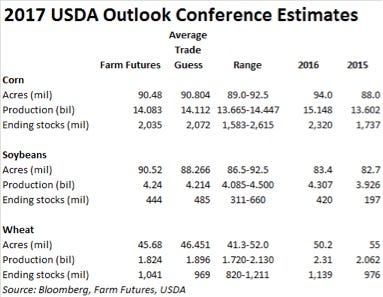
Based on the title and the topic of break-out sessions USDA’s annual get together Thursday and Friday in Arlington, Virginia, will focus on what U.S. farmers, ranchers, food companies and agriculture merchandisers can expect regarding production and farm income for 2017 and beyond.
A key event will be the release Thursday morning of USDA’s forecast for 2017 planted crop acres. Trade surveys (see table) show analysts expect a big increase in soybean acres and a reduction in corn, which is not new as those forecasts have been circulating for a few months.
Farm Futures estimates 2017 planted corn acreage at 90.48 million vs 2016’s 94 million and production at 14.083 billion bushels vs 15.15 billion. Our soybean acreage is forecast at 90.52 million vs 83.4 million and production at 4.24 billion vs 4.31 billion.
A Bloomberg survey of analysts has an average 90.8 million for corn acreage and 14.11 billion for production with soybeans at 88.27 million and 4.21 billion.
“The important thing to remember with these USDA estimates is that they are not based on actual surveys of farmers,” says Bryce Knorr, Farm Futures senior grain analyst. “Results of the agency’s first survey won’t be released until March 31. So these numbers must be taken with more than a few grains of salt.”
The Farm Futures survey was finalized in January, but the ratio of new-crop soybeans to corn has come down a bit since then, said Knorr.
“Another factor to keep in mind is the yields worked into production estimates. USDA tends to be on the high side because they factor in “normal” growing season weather,” said Knorr. “Plus, normal has been a rarity lately. The final yield has come within 1% of trend in only 1 of the last 10 years. Statistically speaking, “average” is a very wide range.”
Sonny Perdue, President Trump’s nomination for Agriculture Secretary, is not on the Forum’s agenda and as of Feb. 21 he was not listed as a registered attendee. In 2009, Secretary of Agriculture Tom Vilsack was confirmed ahead of the Outlook Forum. The Senate Agriculture Committee needs to confirm Perdue and a date has not been set for the nomination hearing.
Michael Young, USDA’s acting deputy secretary will deliver the welcome address. Terry Branstad, the governor of Iowa, and Mike Conaway, chairman of the U.S. House Agriculture Committee, will address the conference on Thursday. Robert Johansson, USDA’s chief economist, on Thursday will give the outlook on 2017 agriculture and foreign trade.
Also on the Forum’s agenda are breakout sessions on food safety and prices, South American agriculture trade, farm policy, and organic agriculture.
Farm Economy
USDA already provided some insight into this year’s farm economy when it predicted a few weeks ago that 2017 farm income should be down 8.7% at $62.3 billion, the lowest since 2002. The drop will largely be due to lower returns on cattle and wheat.
Dairy and cotton producers should have higher returns in 2017, while corn and soybeans returns should be similar to 2016’s.
“Expect to hear lots of gloom and doom about the farm economy out of this conference,” said Knorr. “Many of the speakers, and many in the audience, are policy makers or those representing interests feeding into the sausage making machine that is farm policy. These folks need to waive red flags to their constituents to stay employed, so it’s in their own self-interest to talk about threats to farm income.”
Knorr believes there will be opportunities to price 2017 crops at a profit for growers “ready, willing and able to take advantage of them.”

About the Author(s)
You May Also Like




